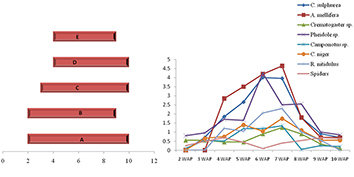Volume 5, Issue 1 (2019)
J. Insect Biodivers. Syst 2019, 5(1): 11-32 |
Back to browse issues page
Download citation:
BibTeX | RIS | EndNote | Medlars | ProCite | Reference Manager | RefWorks
Send citation to:



BibTeX | RIS | EndNote | Medlars | ProCite | Reference Manager | RefWorks
Send citation to:
Emmanuel O, Emmanuel Oludele O, Monday Unwabunne U. Diversity, spatial and temporal distribution of above-ground arthropods associated with watermelon in the Nigerian southern guinea savanna. J. Insect Biodivers. Syst 2019; 5 (1) :11-32
URL: http://jibs.modares.ac.ir/article-36-29780-en.html
URL: http://jibs.modares.ac.ir/article-36-29780-en.html
1- Department of Biological Sciences, Federal University Wukari, Taraba State, Nigeria. , eokrikata@gmail.com
2- Department of Crop and Environmental Protection, Federal University of Agriculture, Makurdi, Benue State, Nigeria.
2- Department of Crop and Environmental Protection, Federal University of Agriculture, Makurdi, Benue State, Nigeria.
Abstract: (4667 Views)
Arthropods were sampled on an early- and late-season crop of watermelon in the 2016 cropping season using motorized suction sampler swept along 5m length of the middle row of 20 experimental plots at Federal University Wukari. Specimens were sorted to morphotypes, feeding guilds and as dominant based on percentage relative abundance (RA) and frequency of occurrence (FO). Different species diversity indices were computed. The collections made on the early- and late-sown crops were compared using Jaccard’s Similarity index (Cj). Spatial distribution pattern of the dominant arthropods were determined using Taylor’s power law and Iwao’s patchiness regression. Results showed that collections on both crops were similar (Cj= 0.83). A total of 14,466 specimens sorted to 1 order (Araneae) in the class Arachnida and 64 species in 41 families and 8 orders in the class Hexapoda were collected. Data showed moderately high species diversity (H = 2.8-3.0), richness (R = 6.0-7.2), but low evenness (E = 0.26-0.39). Coleopterous insects (22 species), dominated by chrysomelids, were the most diverse and species-rich followed by hymenopterans, mainly formicids. Dominant arthropods (RA≥1.0 and FO≥25.0%) included Asbecesta nigripennis, Aulacophora africana, Philanthus triangulum (parasitoid of bee), Pheidole sp., Camponotus sp., Rhynocoris nitidulus and spiders. Most dominant arthropods were aggregated; dispersion varied with model used and crop season. Only 27.3% of the diverse and rich arthropods on watermelon at Wukari require pest management intervention and validation of their dispersion pattern in large-scale watermelon production.
Article Type: Original Research |
Subject:
Systematics/Coleoptera
Received: 2019/01/25 | Accepted: 2019/03/2 | Published: 2019/03/11
Received: 2019/01/25 | Accepted: 2019/03/2 | Published: 2019/03/11
Send email to the article author
| Rights and permissions | |
 |
This work is licensed under a Creative Commons Attribution-NonCommercial 4.0 International License. |









